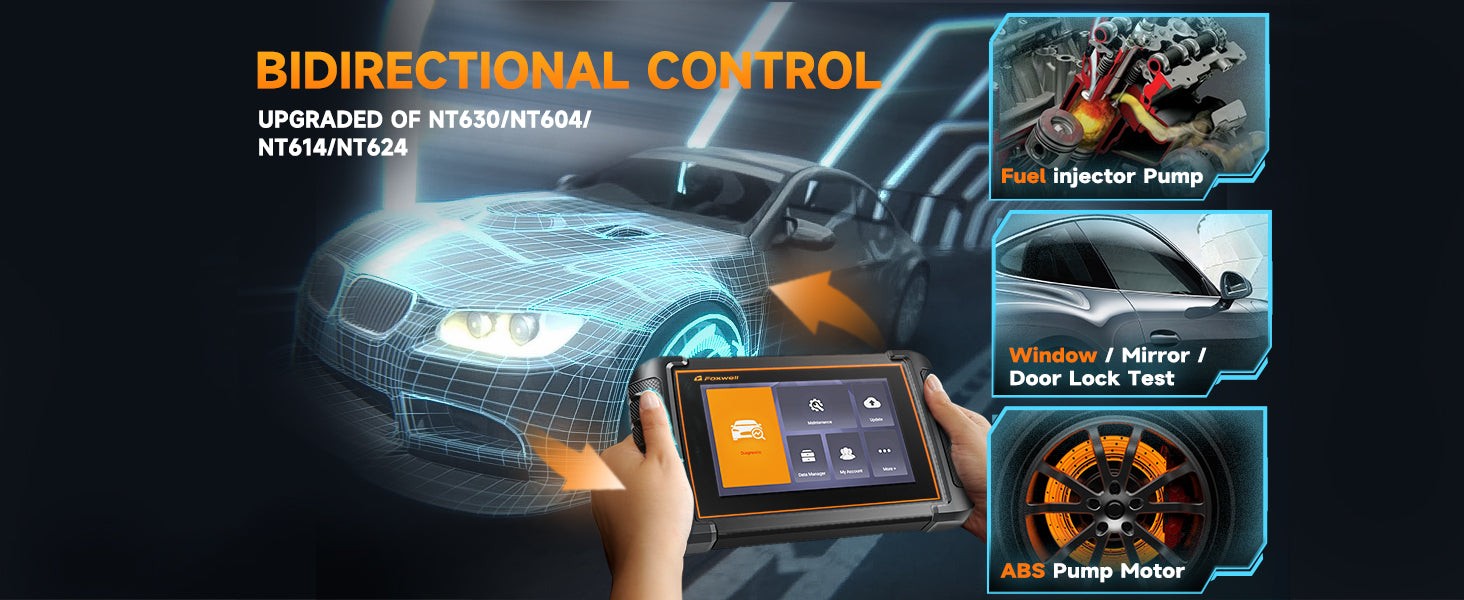Maintaining a vehicle in optimal condition involves understanding various diagnostic and maintenance systems. Two key technologies in modern vehicles are OBD2 (On-Board Diagnostics II) scanners and TPMS (Tire Pressure Monitoring Systems). Both are crucial for vehicle safety and performance, but they serve different functions. This article explores the relationship between TPMS and OBD2 scanners, specifically addressing whether a standard OBD2 scanner is sufficient for TPMS reset or if a specialized tool is required.
 Bi-Directional Control Scanner | Foxwell
Bi-Directional Control Scanner | Foxwell
Understanding Tire Pressure Monitoring Systems (TPMS)
A Tire Pressure Monitoring System (TPMS) is an automated safety system that monitors the air pressure in your vehicle’s tires. These systems provide real-time tire pressure information to the driver, typically through a dashboard indicator light, a pictogram display, or a gauge. This immediate feedback is vital for maintaining optimal vehicle performance, fuel efficiency, and most importantly, safety.
Proper tire inflation is not just about extending tire lifespan or saving on gas; it’s a critical safety factor. A functioning TPMS is essential because maintaining correct tire pressure directly impacts vehicle handling, braking, and overall stability.
Why TPMS is Crucial for Vehicle Safety
The importance of TPMS for vehicle safety cannot be overstated. Driving with under-inflated tires can lead to several dangerous situations:
Reduced Steering and Handling: Under-inflated tires compromise a vehicle’s handling, making it harder to steer, especially at high speeds or in emergency maneuvers. This diminished responsiveness can increase the risk of accidents.
Increased Risk of Tire Failure: Low tire pressure causes tires to flex more, generating excessive heat. This heat buildup can lead to tire blowouts, which are extremely dangerous, particularly at highway speeds.
Longer Braking Distances: Vehicles with improperly inflated tires require longer distances to come to a complete stop. In emergency braking situations, this increased stopping distance can be the difference between a near miss and a collision.
By continuously monitoring tire pressure, TPMS alerts drivers to potential issues before they escalate. This early warning system is a significant contributor to accident prevention and enhanced road safety. Regular vehicle maintenance, including understanding tools like OBD2 scanners and TPMS, is paramount for every vehicle owner.
A frequent question among car owners and technicians is whether a standard OBD2 scanner can handle TPMS resets. To answer this, we need to examine the capabilities of standard OBD2 scanners in relation to TPMS and understand when specialized tools become necessary.
Standard OBD2 Scanner Capabilities and TPMS
OBD2 scanners are primarily designed to diagnose engine and emission-related problems. They excel at reading and clearing diagnostic trouble codes (DTCs) related to the engine control unit (ECU) and emissions systems. These scanners offer valuable insights into engine health and the status of related systems, including, to a limited extent, TPMS.
While OBD2 scanners are excellent for engine diagnostics, their capabilities regarding TPMS are often limited. Here’s a breakdown:
Engine Diagnostics: Standard OBD2 scanners efficiently identify engine issues like misfires, emission control faults, and sensor malfunctions.
Code Reading and Resetting: They can read and reset generic OBD2 diagnostic trouble codes (DTCs) that are standardized across most vehicles. However, TPMS issues often generate manufacturer-specific codes that go beyond the scope of basic OBD2 scanners.
Limited TPMS Functionality: While some standard OBD2 scanners can read basic TPMS-related codes, their ability to perform TPMS resets or sensor programming is generally restricted. They may provide a general warning light related to TPMS, but lack the in-depth functionality needed for comprehensive TPMS maintenance.
Although OBD2 scanners can access data from various vehicle systems, including body control and chassis control, their TPMS capabilities are typically basic, making them insufficient for tasks like TPMS resetting or sensor programming.
When Specialized TPMS Scanners Become Essential
For TPMS reset and programming, specialized scanners are often necessary. Generic OBD2 scanners usually lack the advanced features required to interact fully with TPMS modules. Here’s why dedicated TPMS tools are crucial:
Manufacturer-Specific Protocols: TPMS modules communicate using protocols that are often unique to each vehicle manufacturer. Specialized TPMS scanners are engineered to understand these proprietary protocols, allowing direct and effective communication with the TPMS module.
Advanced Functionality for TPMS Reset: Resetting TPMS often involves more than just clearing codes. It may require sensor relearning, where the system needs to recognize new sensor IDs after sensor replacement or tire rotation. Specialized scanners guide users through these relearn procedures.
Sensor Programming and Activation: Dedicated TPMS tools can program new TPMS sensors and activate them, which is essential when replacing faulty sensors or installing new tires with sensors. This functionality is simply not available in standard OBD2 scanners.
Comprehensive TPMS Diagnostics: TPMS-specific scanners offer in-depth diagnostic features like sensor health checks and real-time data display from each sensor. This detailed information is invaluable for accurate TPMS maintenance and troubleshooting.
Key Features of TPMS-Specific Scanners
Choosing the right diagnostic tool is critical for effective TPMS maintenance. While OBD2 scanners have their place, TPMS-specific scanners provide the necessary capabilities for comprehensive TPMS management. Let’s explore the essential features to look for in a TPMS scanner:
Broad Sensor Compatibility: A good TPMS scanner should support a wide range of TPMS sensors across various vehicle makes and models. Sensor compatibility can vary significantly, so ensuring your scanner covers your vehicle’s sensors is vital.
Robust Sensor Programming Capabilities: The ability to program new sensors is crucial, especially when replacing old or faulty sensors or when switching between tire sets (like summer and winter tires). The scanner should simplify the sensor programming process.
Efficient TPMS Reset and Relearn Procedures: Look for scanners that offer user-friendly reset options and clearly guide you through the sensor relearn process. This is essential after tire rotations, sensor replacements, or when tire pressures have been adjusted.
Live Sensor Data Monitoring: Advanced TPMS scanners provide real-time data from each sensor, including pressure, temperature, and battery status. This live data stream allows for precise diagnostics and monitoring of sensor performance, helping to pinpoint issues quickly.
Foxwell TPMS OBD2 Scanner Options
Foxwell, a reputable provider of automotive diagnostic tools, offers several scanners that excel in TPMS management and reset functionalities. Two notable models are the Foxwell NT310 and Foxwell NT530, both designed to meet the needs of professionals and car enthusiasts seeking reliable TPMS solutions.
Foxwell NT310 TPMS Service Tool: The Foxwell NT310 is specifically designed for TPMS tasks. It provides features for sensor activation, programming, and relearning, along with basic TPMS diagnostics.
User-Friendly Interface: The NT310 is known for its intuitive interface, making TPMS maintenance straightforward for both beginners and experienced technicians.
Foxwell NT530 Multi-System Diagnostic Scanner: The Foxwell NT530 offers broader diagnostic capabilities beyond just TPMS. It provides comprehensive system diagnostics for various vehicle systems, including engine, ABS, airbags, and, importantly, TPMS.
Vehicle-Specific Software: A key advantage of the NT530 is its vehicle-specific software. This allows it to function almost as an OEM (Original Equipment Manufacturer) diagnostic tool for a wide range of brands, ensuring accurate TPMS resets and diagnostics tailored to specific vehicle requirements.
Advanced Bi-directional Functions: The NT530 supports bi-directional tests, enabling users to send commands to vehicle components to perform specific actions. This feature is invaluable for advanced troubleshooting and validating repairs, including within the TPMS system.
Shared Features of Foxwell NT310 and NT530:
- Direct TPMS Support: Both scanners provide direct access to the TPMS module and sensors, allowing for effective monitoring and resetting of the TPMS system.
- Extensive Vehicle Coverage: Foxwell scanners support a broad range of vehicle makes and models equipped with TPMS, making them versatile tools for various automotive service scenarios.
- Regular Software Updates: Foxwell provides regular software updates for both the NT310 and NT530, ensuring compatibility with the latest vehicle models and TPMS technologies.
Foxwell’s NT310 and NT530 models stand out as essential tools in automotive diagnostics, particularly when it comes to Tire Pressure Monitoring Systems, offering a blend of user-friendliness and advanced capabilities.
 Car Scanner Battery | Foxwell
Car Scanner Battery | Foxwell
Conclusion
In summary, while standard OBD2 scanners are valuable tools for general vehicle diagnostics, they typically lack the specialized functions needed for comprehensive TPMS maintenance, particularly TPMS resets and sensor programming. For these tasks, dedicated TPMS scanners like the Foxwell NT310 and NT530 are essential.
The NT310 is a focused, user-friendly tool ideal for TPMS-specific tasks, while the NT530 offers broader vehicle system diagnostics, including advanced TPMS capabilities. Both models ensure that TPMS maintenance is accessible and efficient for both DIY enthusiasts and professional mechanics.
By providing direct TPMS support, vehicle-specific software, and a range of diagnostic functions, Foxwell tools like the NT310 and NT530 are vital for maintaining vehicle safety and performance in modern vehicles. Foxwell’s commitment to innovation and quality is evident in these tools, which are designed to meet the evolving demands of automotive technology.
FAQs
Can the Foxwell NT530 perform TPMS Resets?
Yes, the Foxwell NT530 is equipped to perform TPMS resets as part of its comprehensive vehicle diagnostics suite. It’s an excellent tool for complete vehicle system analysis, including TPMS.
Is the Foxwell NT310 Suitable for Professional Use?
Absolutely. The Foxwell NT310, with its specialized TPMS functionalities like sensor triggering, programming, and relearning, is a valuable asset for professional automotive repair shops and service departments focusing on tire and wheel services.
Do Foxwell Scanners Receive Updates for New Vehicle Models?
Yes, Foxwell regularly provides software updates for their NT310 and NT530 scanners. These updates ensure ongoing compatibility with new vehicle models and the latest advancements in automotive and TPMS technologies, keeping your tool relevant and effective.